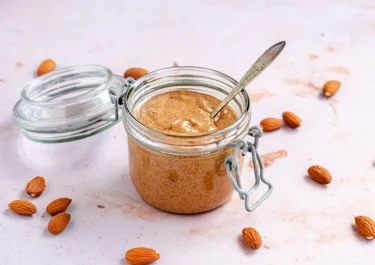Almond butter

Delight in making your own almond butter, a smooth and versatile spread that's both delicious and a source of protein. This recipe transforms simple raw almonds into a rich paste with just a pinch of fine sea salt and your choice of aromatic spices like cinnamon, cardamom, or vanilla to make it your own. Enjoy it on toast, in smoothies, or as part of your baking recipes. So, heat your oven, get your food processor ready, and prepare for a journey into the world of nutty goodness.
Ingredients
|
300 g
Almonds, raw
|
|
|---|---|
|
1 pinch
Fine sea salt
|
|
|
Cinnamon, ground cardamom or vanilla powder (to taste)
|
Instructions
Questions about almond butter
Making this recipe is both rewarding and delicious. Here, we address common questions and provide helpful tips to ensure you achieve the perfect homemade almond butter every time.
What is the best way to store homemade almond butter, and how long does it stay fresh?
Store in a clean, airtight glass jar in the fridge. This will keep it fresh for up to two weeks. Ensure you always use a clean spoon to avoid introducing bacteria, which can shorten its shelf life. If you prefer storing it at room temperature, it should be consumed within a week and kept in a cool, dark place, away from direct sunlight and heat sources.
What creative uses are there for homemade almond butter?
Homemade almond butter is incredibly versatile. Spread it on toast or rice cakes for a quick snack or use it as a dip for fresh fruits like apple slices and bananas. Stir it into protein overnight oats or baked oats with eggs for added flavour and creaminess. Try making little sandwiches out of mini protein pancake bites with almond butter in-between. You can also use it to make scrumptious protein flapjacks. Of course, it’s a delicious addition to smoothie bowls as well, providing a rich, nutty flavour and creamy texture. Keep in mind that, when adding your almond butter to other snacks, it could change the nutritional profiles, including the protein content.
Can I make this recipe with a standard food processor?
Absolutely! While high-powered blenders can produce almond butter more quickly, a standard food processor works perfectly well. Process the roasted almonds in intervals, scraping down the sides as needed, until you achieve a smooth, creamy consistency. Be patient, as this may take several minutes. Adding a small amount of water can help speed up the process if needed. With a bit of time and persistence, your standard food processor will yield delicious homemade almond butter.
Quick fixes for a too thick or dry almond butter
If your almond butter is too thick or dry, adding a small amount of warm water can help achieve the desired consistency. Start with a teaspoon and blend thoroughly, adding more if needed. Always ensure you blend well after each addition to maintain a smooth texture.
Master the art of almond roasting
Mastering the art of almond roasting is key to making delicious almond butter with a rich, deep flavour. Start by spreading raw almonds in a single layer on a baking sheet to ensure even roasting.
Stir them occasionally to prevent burning and promote uniform browning. Always keep a close eye on them, as nuts can quickly go from perfectly roasted to overly charred.
Once they turn a golden brown and release a fragrant aroma, remove them from the oven and let them cool completely. Roasting enhances the almonds' natural oils, making your almond butter smoother, more flavourful, and easier to blend.
Almond selection for a smooth almond butter
For the best results, choose high-quality raw almonds. Raw almonds allow you to control the roasting process, ensuring optimal flavour and texture. Look for uniform-sized nuts, as they roast more evenly. Freshness is also important; stale almonds can affect the taste of your almond butter. If you prefer a richer flavour, lightly roast the almonds before blending. Avoid pre-roasted or salted almonds, as they can alter the final spread’s taste and texture.
Take your time when blending the almonds
Patience is crucial when making almond butter. Initially, the almonds will turn into a fine flour. As you continue blending, they will clump together before eventually releasing their oils and transforming into smooth almond butter.
This process can take 10-15 minutes. Be sure to scrape down the sides of the food processor periodically to ensure even blending. Rushing this process or adding liquids too early can result in a grainy texture.
Lesser-known preparation techniques
For an extra depth of flavour, try soaking the almonds in salted water overnight before roasting them; this enhances their natural sweetness and adds a subtle savoury note. Additionally, you can experiment with sprouting the almonds by soaking them for 12 hours, draining, and then allowing them to sit in a jar with a mesh cover for another day or two until tiny sprouts appear.
Sprouted almonds offer a unique, slightly earthy flavour. These small adjustments can transform your almond butter into a gourmet delight, perfect for both sweet and savoury dishes.








